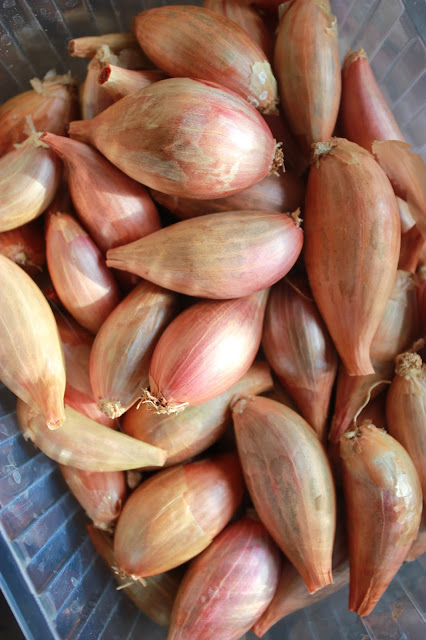A mirepoix is often the best way to start a sauce or stew. Ingredients vary but usually consist of carrots, celery, and onions. The finely chopped veggies are sauteed, actually closer to being braised, in a good amount of olive oil or butter.
For the lentil sauce, I subbed shallots for the onions and added tomatoes along with some fresh basil, all from our potager.
Lentilles Vertes du Puy are described as green, but they are more speckled than anything else. These tiny, delicious discs stay firm after cooking while tasting of black pepper and hazelnuts. Grown in Le Puy-en-Velay, a commune in the Haute-Loire department near the Loire river, they have been given an AOC.
For around a litre and a half of lentil sauce, finely dice one medium carrot, one celery stalk, and four shallots. In two tablespoons of warmed olive oil and over low heat, saute the vegetables. Stir frequently. Their aroma will fill the air as they become translucent and soft which takes about fifteen minutes.
Add three diced medium tomatoes and continue to simmer with occasional stirring for another ten minutes. Towards the end, toss in a small handful of basil leaves which have been finely minced.
Stir in 370 ml of rinsed lentils.
Pour in a litre of either water or broth (I used homemade chicken but a veggie one is fine). Bring to a simmer and cook gently for forty-five minutes. Add liquid if it becomes too dry. Salt to taste as lentils become tough when salted during cooking. Remove any tomato skins that have risen to the surface.
The sauce can be frozen or used as a base for lentil soup (just add more broth) or served over brown rice/polenta. In this case I made pasta enough for two, drained it, added several ladles of sauce which was partially pureed via a stick mixer, a few tablespoons of cream, and salted the mixture to taste making sure that it was wet enough to withstand the drying effect of baking. The pasta was placed in a baking dish and covered with lots of Gruyère. Baked for about ten minutes in a 177 degrees C oven, it became creamy but crusty and totally wonderful. For a larger amount, layers would be more appropriate, alternating between pasta and cheese which would require a longer baking time.
Gruyère was chosen because it melts so well.
Though most pasta shapes will be suitable for this dish, small shells double as adorable little serving platters.
À la prochaine!
For the lentil sauce, I subbed shallots for the onions and added tomatoes along with some fresh basil, all from our potager.
 |
| Shallots are my 'desert island' vegetable as they are sublime |
Lentilles Vertes du Puy are described as green, but they are more speckled than anything else. These tiny, delicious discs stay firm after cooking while tasting of black pepper and hazelnuts. Grown in Le Puy-en-Velay, a commune in the Haute-Loire department near the Loire river, they have been given an AOC.
For around a litre and a half of lentil sauce, finely dice one medium carrot, one celery stalk, and four shallots. In two tablespoons of warmed olive oil and over low heat, saute the vegetables. Stir frequently. Their aroma will fill the air as they become translucent and soft which takes about fifteen minutes.
Add three diced medium tomatoes and continue to simmer with occasional stirring for another ten minutes. Towards the end, toss in a small handful of basil leaves which have been finely minced.
Stir in 370 ml of rinsed lentils.
Pour in a litre of either water or broth (I used homemade chicken but a veggie one is fine). Bring to a simmer and cook gently for forty-five minutes. Add liquid if it becomes too dry. Salt to taste as lentils become tough when salted during cooking. Remove any tomato skins that have risen to the surface.
 |
| The speckles vanished! |
The sauce can be frozen or used as a base for lentil soup (just add more broth) or served over brown rice/polenta. In this case I made pasta enough for two, drained it, added several ladles of sauce which was partially pureed via a stick mixer, a few tablespoons of cream, and salted the mixture to taste making sure that it was wet enough to withstand the drying effect of baking. The pasta was placed in a baking dish and covered with lots of Gruyère. Baked for about ten minutes in a 177 degrees C oven, it became creamy but crusty and totally wonderful. For a larger amount, layers would be more appropriate, alternating between pasta and cheese which would require a longer baking time.
Gruyère was chosen because it melts so well.
Though most pasta shapes will be suitable for this dish, small shells double as adorable little serving platters.
 |
| A sprinkling of fleur de sel is a nice touch |
À la prochaine!







No comments:
Post a Comment
Note: only a member of this blog may post a comment.